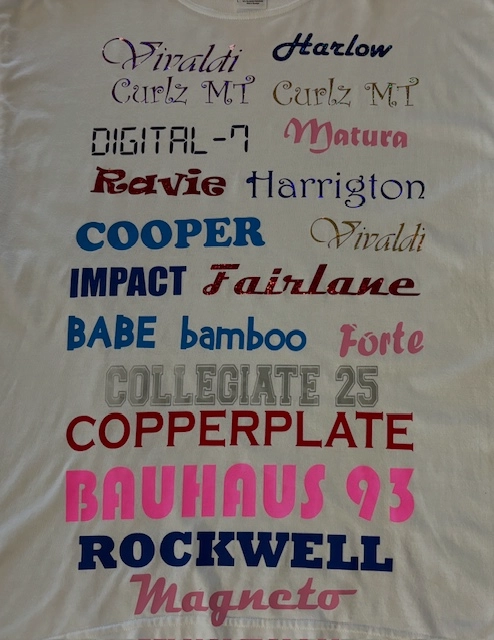The Art of Personalized Embroidery: Opening the Tricks to Creating Unique and Memorable Styles
Needlework, a craft steeped in tradition and virtuosity, holds within its elaborate stitches the power to transform material right into a canvas of special expression. The keys to developing custom embroidery styles that astound the eye and leave a lasting impression lie in a fragile equilibrium of method, imagination, and interest to information. As we dive into the world of custom-made needlework, we discover the nuanced interaction in between string selection, sew intricacy, and layout personalization that boosts a mere garment to a masterpiece. Join us on a trip with the art of custom-made needlework as we decipher the mysteries behind crafting absolutely memorable and distinctive productions.
Picking the Right Needlework Threads
When selecting needlework threads, what vital factors should you think about to guarantee the ideal outcomes for your custom-made layouts? The selection of embroidery thread is essential in figuring out the final end result of your embroidered design.
Furthermore, the weight or thickness of the string plays a substantial function in the appearance of the embroidery. Thicker strings can add dimension and structure to your design, while finer threads are optimal for detailed information and small message. In addition, considering the color fastness and washability of the string is crucial to make sure that your custom-made layouts keep their quality and vibrancy with time. By carefully reviewing these elements and selecting high-grade strings that satisfy your specific demands, you can improve the aesthetic charm and durability of your embroidered creations.
Exploring Different Stitch Strategies
To explore the world of 'Checking out Various Stitch Strategies', one should understand the intricacies and nuances that each sewing technique brings to the art of needlework. Various stitch methods not only add visual rate of interest but likewise add to the overall texture and measurement of the design. One popular stitch technique is the satin stitch, which entails very closely jam-packed parallel stitches to produce a smooth and shiny surface, ideal for filling in shapes and creating bold describes.
On the other hand, the backstitch is a functional strategy commonly used for outlining and including great information. It includes sewing backwards to develop a solid line of needlework. Furthermore, the French knot stitch includes a tactile aspect to styles, excellent for creating textured accents like flower facilities or ornamental touches.
Checking out different stitch methods enables embroiderers to have fun with light, shadow, and deepness within their styles, elevating the visual allure and artistic top quality of their needlework tasks. By mastering various sewing methods, one can unlock endless opportunities for developing unique and memorable personalized needlework pieces.
Incorporating Personalized Layout Components
Having actually explored the complexities of various stitch strategies such as the satin stitch, backstitch, and French knot, the focus now changes towards including customized style aspects in customized embroidery jobs. Customized design elements play a critical function in making needlework projects really unique and remarkable.
Another method to incorporate tailored style elements is by including symbols or motifs that hold unique meaning to the recipient or mirror their interests and character. For instance, including a favorite flower, pet, or hobby-related sign can make the embroidery style extra meaningful and customized. Additionally, picking shades that reverberate with the recipient or straighten with the designated theme can additionally enhance the customization of the needlework task.
Understanding the Art of Shade Coordination

One secret aspect of shade control is recognizing color concept. This includes knowing exactly how various shades engage with each various other, the feelings they share, and exactly how they can be combined to develop visually enticing layouts. By using shade theory concepts, embroiderers can develop unified shade schemes that improve the overall appearance of the style.
Furthermore, paying attention to comparison is important in color coordination. Making use of contrasting colors can help specific elements of the design pop, boost readability, and create a visually dynamic needlework item. By grasping the art of color control, embroiderers can elevate their layouts and develop memorable items that reverberate with customers and visitors alike.
Enhancing Appearance With Advanced Needlework Stitches
Bullion knots, on the various other hand, can be utilized to produce twisted, ropelike components that add a glamorous feeling to the needlework. Trying out with these advanced embroidery stitches enables you to push the boundaries of standard needlework and produce truly one-of-a-kind and aesthetically attractive appearances in your layouts.
Final Thought
Finally, the art of custom-made embroidery involves a mix of picking the appropriate strings, checking out various stitch strategies, integrating individualized layout components, grasping shade sychronisation, and improving texture with advanced stitches. By comprehending and executing these vital elements, embroiderers can develop distinct and memorable layouts that display their creative thinking and ability. Embroidery fanatics can open the keys to creating beautiful and bespoke items that stick out and leave a long a fantastic read lasting impression.